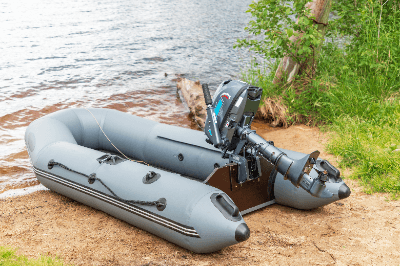What Is a Rubber Boat?

A rubber boat is a vessel with a tube-shaped hull, designed to navigate on water by injecting air or gas. It is also known as an inflatable boat, featuring easy storage and portability by deflating. Due to its buoyant hull, the rubber boat has minimal sinking in water and can navigate steadily with minimal force.
The sizes and shapes of rubber boats vary, ranging from single-person hand-rowed boats to larger ones equipped with outboard motors. For the use of powerboats, a driving license is not required if the length is less than 3 meters and the output is less than 2 horsepower.
Uses of Rubber Boat
Rubber boats, being compact and lightweight, have diverse applications. They are commonly used in leisure activities, disaster rescue operations, and are frequently stored on larger ships. The ease of storage and portability are significant reasons for their widespread use.
1. Leisure
Utilized for enjoyable activities such as fishing in seas or lakes and recreational boating like river rafting.
2. Disaster Rescue
Deployed during disasters like heavy rains or water-related accidents for rescue operations.
3. Transportation
Used as a means of transport in areas where medium or large ships cannot navigate, such as shallow waters.
4. Other
Deployed as a life raft during emergencies for evacuating from ships.
Principles of Rubber Boat
The rubber boat floats on the water’s surface due to the buoyancy generated underwater. The term “inflatable” in the rubber boat alternatively refers to the inflation of air, providing the buoyancy that keeps it afloat. Therefore, a rubber boat floats by the inflating air.
Types of Rubber Boat
Rubber boats come in two main types: powerboats equipped with outboard motors and rowboats propelled manually. While powerboats and rowboats have distinct features and uses, they share the versatility of being used in various situations. Moreover, their compact size allows for easy handling and storage.
1. Powerboats
Equipped with outboard motors, powerboats can be navigated using power, suitable for longer-range travel.
2. Rowboats
Rowboats are manually propelled using oars, making them lightweight and easy to operate, ideal for beginners.
How to Choose a Rubber Boat
Choosing the right rubber boat involves considering several factors, including durability, passenger capacity, and the ability to attach an outboard motor. Careful selection is crucial to avoid increased risks.
1. Durability
Durability is paramount for rubber boats, and it varies based on the material. Consider the usage location, as some may become unusable within a few years.
2. Passenger Capacity
Consider the designated passenger capacity, which is generally half of the stated capacity, accounting for gear and luggage.
3. Outboard Motor
Select a powerboat if planning to attach an outboard motor for motorized navigation.
4. Floor Type
There are broadly three types:
- Air Floor
A type that inflates by pumping in air. - Wood Floor/Aluminum Floor
An assembly-type that allows stable navigation, either with a wooden or aluminum structure. - Roll-up Floor
An easy-to-assemble and dismantle type, recommended for beginners.
Structure of Rubber Boat
Rubber boats are made of two main materials: CSM and PVC, each influencing durability, weather resistance, and usable lifespan.
1. CSM
CSM offers superior durability and weather resistance, lasting around 10 to 15 years. It is not influenced by temperature changes and, while more expensive than PVC, has the advantage of being repairable.
2. PVC
PVC has a usable lifespan of 5 to 10 years but may become unusable sooner depending on the usage location. It exhibits temperature-related characteristics and is more affordable than CSM, offering sufficient performance.
Other Information on Rubber Boat
Considerations When Using Rubber Boats
Rubber boats can be easily maneuvered with minimal force but are susceptible to wind effects. Caution is necessary regarding wind direction and force during use.
Moreover, in rocky or shallow areas, there is a risk of damaging the rubber boat. Safety equipment such as life jackets should be provided to ensure safety.